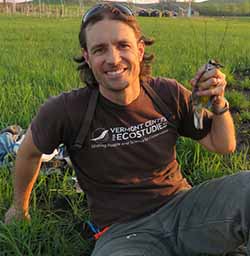Climate change is causing mountains to warm twice as fast as the rest of the world, and mountaintops perhaps at five times the global rate. Distributions of many montane plant and animal species are already shifting poleward and to higher elevations; data suggest that this rate of movement is increasing for some species (e.g., the American Pika, Ochotona princeps). In the northeastern US, models predict that more than 50% of the Picea spp.— balsam fir (Abies balsamea)—forest will be lost due to the upslope movement of hardwoods over the next two centuries. Unsurprisingly, species distribution models in conjunction with forecasts of climate change predict that most of the existing breeding-bird species of the spruce–fir zone will be absent as breeders from the northeastern US by the end of this century. We used ten years of community science data from more than 700 high-elevation sampling locations from the Mountain Birdwatch program to model the rate of elevational and latitudinal shifts in breeding-bird species of the northeastern US, including Bicknell’s Thrush (Catharus bicknelli), Blackpoll Warbler (Setophaga striata), and White-throated Sparrow (Zonotrichia albicollis). Elevational-specific population trends and population trajectories were calculated using data from both the southern (i.e., the Catskill Mountains of New York) and northern periphery of the breeding range for these species. We hope our results spur targeted regional conservation and management actions and help improve future connectivity and species-distribution modeling efforts.

Growing up in Iowa, Jason Hill was fascinated by the way the natural world managed to exist in a heavily modified agricultural landscape. His biocentric wonder led him to New England, where he is a quantitative ecologist with the Vermont Center for Ecostudies helping to oversee the citizen science project, Mountain Birdwatch, and research into montane ecology. A quantitative ecologist and ornithologist by training, Jason joined the Vermont Center for Ecostudies in January 2015. A lifelong birder and naturalist, Jason followed graduation from the University of Montana (a B.S. in Wildlife Biology) with a series of wildlife-based adventures that found him monitoring sea otters in California, tracking endangered Red-cockaded Woodpeckers in Florida, and researching House Wrens at La Selva Biological Station in Costa Rica. On Maui, his crew was tasked with capturing the three remaining po’ouli: a Hawaiian honeycreeper that is now thought to be extinct.
Jason investigated the post-fledgling ecology of Saltmarsh Sparrows at the University of Connecticut for his M.S. in Ecology and completed his Ph.D. in with the Pennsylvania Cooperative Fish and Wildlife Research Unit at Penn State University, studying the population ecology of grassland sparrows following experimental landscape manipulation. During a cooperative post-doc between the Pennsylvania Cooperative Fish and Wildlife Research Unit and the Patuxent Wildlife Research Center, Jason estimated the effects of landscape changes from Marcellus natural gas development on the populations of interior forest and grassland bird species.
At the Vermont Center for Ecostudies, Jason primarily investigates avian ecology within the montane spruce-fir community, but he also coordinates the Suds & Science discussion series and cranks out R and BUGS code on demand for his colleagues.

